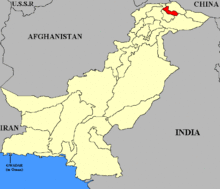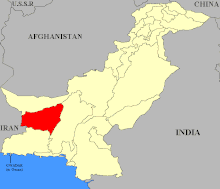Princely states of Pakistan
 |
| This article is part of the series |
| Former administrative units of Pakistan |
|---|

The princely states of Pakistan (
At the time of the withdrawal of British forces from the subcontinent on 15 August 1947, West Pakistan was less than half of its ultimate size. It took a year of negotiations and accidents to bring the princely states into Pakistan, and a long process of integration followed.[1][2]
Options of the Princes

Amir of Bahawalpur, as used in 1949
| Princely state |
|---|
| Individual residencies |
|
| Agencies |
|
| Lists |
With the withdrawal of the British from the
Only two rulers acceded to Pakistan in the first month of its independence, August 1947, while the others considered what to do, but most of those states with a Muslim majority population had acceded to Pakistan within a year, prompted in several cases by the
The
The princely state of
Princely states of Pakistan in order of accession
Bahawalpur

On 3 October 1947, after some delay, the Nawab (or Ameer) of
Khairpur

The state of
In 1950 the Amir introduced a form of democracy, with universal adult franchise. In 1955 the state was integrated into Pakistan.[17] The royal privileges of the Amir were abolished in 1972.
The last Amir is one of the few surviving princes.[19]
Chitral

The Mehtar of Chitral, Muzaffar-ul-Mulk (1901–1949), stated his intention to accede to Pakistan on 15 August 1947.[20] However, his formal accession was delayed until 6 October.[14][5] He died in January 1949. His son, Saif-ur-Rahman (1926–1954), had been exiled by the Government of Pakistan and a board of administration composed of Chitrali noblemen was to govern the state in his absence. In October 1954 Saif-ur-Rahman was allowed to return from exile to take charge of Chitral, but he died in a plane crash on the way home, leaving his four-year-old son Mohammad Saif-ul-Mulk Nasir (1950–2011) as ruler. His uncle, Shahzada Asad ur-Rahman, acted as Regent until he came of age and was invested with the full powers of Mehtar at Chitral Fort in May 1966.[21]
On 28 July 1969, President Yahya Khan announced the full integration of the states of Chitral, Dir, and Swat into Pakistan,[22] and the dispossessed young ruler, then aged nineteen, agreed to take up a diplomatic career. He joined the Foreign Service in 1973 and served as First Secretary at Ankara, 1974–1979, as Deputy Chief of Protocol in the Ministry of Foreign Affairs, 1979–1985, and as Assistant Consul-General in Hong Kong, 1985–1989.[21]
Swat

The
Hunza
Nagar

Nagar was another small valley state to the north of Kashmir and shared the language and culture of Hunza.[27] In 1931 it had a population of 13,672, much the same as that of Hunza.[24] On 18 November 1947 its ruler, Shaukat Ali Khan (1917–2003), who had come to the throne in 1940, joined his neighbour in acceding to Pakistan.[27] They did this after resisting considerable pressure from Hari Singh of Jammu and Kashmir to enter into new subsidiary alliances with him.[28]
In 1968 Syed Yahya Shah, a politician of the valley, demanded civil rights from the Mir of Nagar. On 25 September 1973, not long after the Pakistan People's Party under Zulfiqar Ali Bhutto had come to power, the new government forced the last Mir of Nagar, Brigadier Shaukat Ali Khan, to abdicate his power, as with the Mir of Hunza, and like Hunza, Nagar was merged into the Northern Areas, although the Mir of Nagar was left with some of his purely ceremonial role.[29]
Amb

On 31 December 1947,
A small state, in 1958 Amb was reported to have an area of 1,520 square kilometres (585 square miles) and a population of 48,656.[31]
Phulra

Phulra was a khanate near Amb, with a population of about 8,000 and an area of only 93 square kilometres (36 square miles).
Dir

The Nawab of
Las Bela

Kharan

With an area of 47,940 square kilometres (18,508 square miles) and a population reported in 1951 as 33,833,[35] Kharan was one of the princely states of Balochistan which retained some degree of their independence for several years. Its last Nawab was Habibullah Khan Nausherwani a Baloch chief (1897–1958), who was in power from 1911 until 1955.[36]
The state acceded to Pakistan on 17 March 1948, which was accepted on the same day.[14] On 21 March 1948, the rulers of Kharan, Makran, and Las Bela all announced that they were acceding their states to the Dominion of Pakistan.[34]
Makran

Also on 17 March 1948, Makran acceded to Pakistan,[14][34] and on 3 October 1952 it formed the Baluchistan States Union with Kalat, Kharan and Las Bela. Makran was dissolved on 14 October 1955, when it was merged into the province of West Pakistan. In 1970, the area of the former state was organized as the Makran District (later the Makran Division) of the province of Baluchistan.
Khanate of Kalat

The
On 20 June 1958,
See also
References
- ^ Yaqoob Khan Bangash, A Princely Affair: The Accession and Integration of the Princely States of Pakistan, 1947-1955 (Oxford University Press, 2015), introduction.
- ^ Bangash, Yaqoob Khan (14 August 2022). "Winning Over The Princely States". DAWN.COM. Retrieved 24 July 2023.
- ^ Ishtiaq Ahmed, State, Nation and Ethnicity in Contemporary South Asia (London & New York, 1998), p. 99
- ^ R. P. Bhargava, The Chamber of Princes (Northern Book Centre, 1991) p. 313
- ^ a b Axmann, Back to the Future (2008), p. 273.
- ^ Lindsay Brown, Paul Clammer, Rodney Cocks, Pakistan & the Karakoram Highway (2008), p. 296
- ^ "Junagadh" in John Mcleod, Historical Dictionary of the British Empire, Volume 1, p. 614: "In order to compel Mahabatkhanji to reverse his accession, India sent troops to the surrounding states and imposed a blockade"
- ISBN 8184751850)
- ISBN 978-969-8181-03-1.
- ^ Srinath Raghavan, War and Peace in Modern India (2010), p. 63
- ^ Rajmohan Gandhi, Patel: A Life (India: Navajivan, 1992), p. 292
- ^ Accession of Junagadh: Farce of History, revisitingindia.com, 28 Aug 2013.
- ^ KARACHI: Nawab Moinuddin laid to rest, dawn.com, 15 Feb 2003, accessed 29 October 2020
- ^ a b c d e f g h i Wilcox, Pakistan: The Consolidation (1963), p. 82
- ^ Umbreen Javaid, Politics of Bahawalpur: From State to Region, 1947-2000 (2004), p. 115
- ^ The All Pakistan Legal Decisions, vol. 30, part 2 (1978), p. 1,171
- ^ a b Siddiqi, The Politics of Ethnicity in Pakistan (2012), p. 130.
- ^ Pakistan Constituent Assembly Debates: Official report, vol. 1 (issues 1-1950, 1947), p. 152
- ISBN 9781317448204) pp. 94–95
- ^ Kuldip Singh Bajwa, Jammu and Kashmir War, 1947-1948 (2003), p. 141
- ^ a b Brief History of Ex Mehter Chitral HH Prince Saif ul Mulk Nasir Archived 29 October 2013 at the Wayback Machine, chitraltimes.com, accessed 31 October 2020
- ^ a b c Muhammad Sher Ali Khan, The elite minority, the princes of India (1989), p. 98: "On 28 July 1969, President Yahya Khan announced in a broadcast to the nation... that his administration had decided that the time has come to merge the states of Chitral, Dir and Swat in West Pakistan"
- ^ Brown, Clammer, & Cocks (2008), p. 209
- ^ a b Census of India, 1931, Volume XXIV: Jammu & Kashmir State, Part 1 – Report (India Census Commissioner Manager of Publications, 1933), p. 59
- ^ Z. H. Zaidi, ed., Jinnah Papers: The states: Historical and Policy Perspectives and Accession to Pakistan, vol. VIII (Quaid-i-Azam Papers Project, Government of Pakistan, 2003), p. 113
- ISBN 978-0-231-70013-9. Retrieved 26 February 2012.
- ^ a b c Pakistan Horizon, vol. 56, Issues 1-2, p. 57: "Hunza and Nagar acceded to Pakistan on November 18, 1947, but the northern regions have not been merged into Pakistan proper, pending the determination of the status of Jammu and Kashmir."
- ^ William Brown, Gilgit Rebellion: The Major Who Mutinied Over Partition of India (2014), pp. 66–68
- ^ Pakistan Pictorial Issue 1 (Pakistan Publications, 1973), p. 8: "The Rajas of Punial, Ishkoman, and Gupis, as also the Mir of Nagar, have been allowed to retain their ceremonial rights but the economic privileges, like levy of taxes for the entertainment of their guests, and other such, have been cancelled."
- ^ a b Z. H. Zaidi, CHRONOLOGY OF ACCESSION OF STATES TO PAKISTAN in Quaid-i-Azam Mohammad Ali Jinnah Papers: The States (Quaid-i-Azam Papers Project, 1993), p. xxxix
- ^ a b Amiya Ranjan Mukherjee, Current Affairs (1958), p. 337
- ^ Memoranda on the Indian States (Published by Authority, 1939), p. 215
- ^ Sir Terence Creagh Coen, The Indian Political Service: A Study in Indirect Rule (1971), p. 144
- ^ a b c Siddiqi (2012), p. 60: "The rulers of the states of Kharan, Makran and Lasbela announced their decision to join the Pakistan dominion on 21 March 1948 and their respective rulers signed the official documents."
- ^ a b Joseph Whitaker, Whitaker's Almanack 1951, vol. 83 (1951), p. 754: "the following States have also acceded to Pakistan : ]Kalat, area 53,995 square miles [139,850 square kilometres], pop. 253.305; Kharan, area 18,508 square miles [47,940 square kilometres], pop. 33,83a; Las Best, 7,043 square miles [18,240 square kilometres], pop 69,067; The North West Frontier States of Amb, Chitral, Dir."
- ^ M. Epstein, ed., The Statesman's Year-Book: Statistical and Historical Annual of the States of the World for the Year 1942 (1942), p. 166; West Pakistan District Gazetteers: Kharan (Printed at the West Pakistan Government Press, 1966), pp. 30–32
- ^ Farhan Hanif Siddiqi, The Politics of Ethnicity in Pakistan: The Baloch, Sindhi and Mohajir Ethnic Movements (Routledge, 2012), pp. 58–62
- ISBN 978-0313321092), p. 258
- ^ Mohammed Yousuf, Balochistan Tango at despardes.com
Bibliography
- Martin Axmann (2008), Back to the Future: The Khanate of Kalat and the Genesis of Baloch Nationalism, 1915-1955, Oxford University Press, ISBN 978-0-19-547645-3
- Bangash, Yaqoob Khan (2015), A Princely Affair: The Accession and Integration of the Princely States of Pakistan, 1947-1955, Oxford University Press, USA, ISBN 978-0-19-906649-0
- Bangash, Y. K. (2015), "Constructing the state: Constitutional integration of the princely states of Pakistan", in Roger D. Long; Gurharpal Singh; Yunas Samad; Ian Talbot (eds.), State and Nation-Building in Pakistan: Beyond Islam and Security, Routledge, pp. 76–100, ISBN 978-1-317-44820-4
- Behera, Navnita Chadha (2007), Demystifying Kashmir, Pearson Education India, ISBN 978-8131708460
- Copland, Ian (February 1991), "The Princely States, the Muslim League, and the Partition of India in 1947", The International History Review, 13 (1): 38–69, JSTOR 40106322
- Copland, Ian (2005), State, Community and Neighbourhood in Princely India, c. 1900–1950, Palgrave Macmillan, ISBN 0230005985
- Siddiqi, Farhan Hanif (2012). The Politics of Ethnicity in Pakistan: The Baloch, Sindhi and Mohajir Ethnic Movements. Routledge. ISBN 978-1-136-33697-3.
- Wilcox, Wayne Ayres (1963), Pakistan: The Consolidation of a Nation, Columbia University Press, ISBN 978-0-231-02589-8
